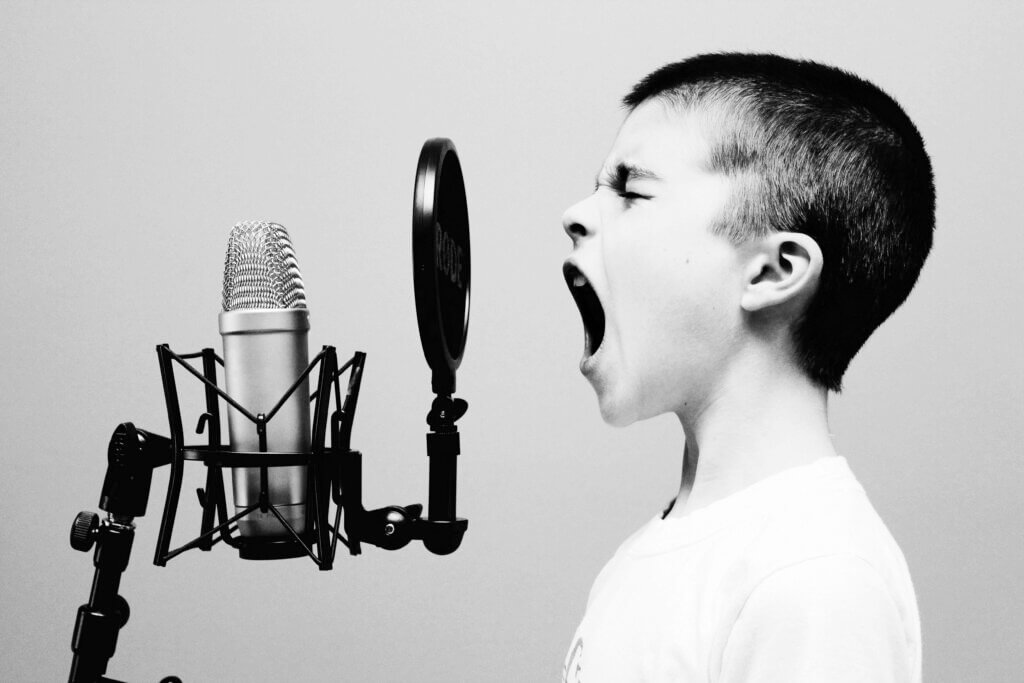Check out the entire special VOCAL CHAIN ISSUE here.
One of the most effective ways to get your songs above the fray and to the next level is by recording great harmonies and background vocals. Over the years we have found that the bigwigs in the music biz love to hear excellent lead vocals AND quality harmonies/background vocals. The problem we have observed is that many artists are used to hearing backing tracks and harmonies on songs without really noticing them. They know a song sounds good but when asked if there are vocal backing tracks on that recording, many actually don’t hear them until they’re pointed out. A lot of bands do not fully understand what vocal backing and harmonizing is until they get into the studio, but with a little coaching, most can learn how to record a good harmony and will soon be trying to write harmonies for all their songs.

At this point you must be asking yourself the burning question: What is the best way to record a harmony/background vocal?! In this article, we will detail some of the techniques that we have found are the most successful for recording, as well as some mixing tricks that will help give you those sexy harmonies to make your tracks pop!
STEP ONE…
The first thing that you should do when getting ready to record harmonies and background vocals is to have rehearsed and written vocal parts before the session! Many bands do not even think about this, so if you want to save yourself some money, spend a little rehearsal time working out some background vocals before going into the studio. Once you have your background vocals rehearsed, you must then figure out who will be singing them. Some groups will only have a lead vocalist, so in these instances you will have him/her record harmonies to their already-tracked lead part. In other cases, you may have multiple vocalists. Once you have all of this established, you are ready to move on to the next step, which is…
HEADPHONE MIXES
Every engineer’s favorite thing in the whole recording world! (Note the sarcasm). Getting the perfect headphone mix can be one of the most time-consuming parts of any session, much to the dismay of us engineers. At Night Train Studios, we have recently opted to use a Personal Mixer system. This allows for the artist to control their own headset mixes, which has made our lives (and theirs) a lot easier.
But many studios still use a more traditional headphone amp system, where you have to manually adjust the headset mixes of your artist, so there are some good tricks to keep in mind. One thing we would recommend trying is adding some reverb to the vocals. A little reverb can help your performer feel a little less “naked” when they hear themselves through the cans, and give them more confidence while performing. Most singers do better hearing themselves naturally, which will often times play a role in deciding which headphones we will select. There are two categories that most headphones fall into – closed and open. Closed cup phones block out much of the ambient room sound and work great when other loud instruments are present; they also help keep the music from leaking into a hot mic.
Open cup (like the AKG K 240) have a more natural feel but allow more unintentional leakage. If time allows, let the talent audition a few different pairs to see which they prefer. Headphones give singers a version of themselves that they may not be used to, so we often suggest they experiment a bit as they warm up by moving one cup off their ear until they find a sweet spot between the room and headphone mix. Once a vocalist finds a pair of headphones they like, we often recommend that they purchase a pair and use them all the time so that singing with them on becomes second nature.
MIC TECHNIQUE AND SELECTION
Background vocals rehearsed: Check! Headphone mix created: Check! Now we need to pick out which mic we’re going to use. We almost always use a pop filter to help eliminate plosives P’s and B’s when recording background vocals. We also like to use a mic isolation shield (like the Auralex MudGuard) to help minimize unwanted room reflections that can color a vocal performance. These are especially helpful if you are forced to record in a less-than-optimal space. While there is no right or wrong answer when it comes to mic selection, you hardly ever can go wrong with a large (3/4” – 1”) diaphragm condenser mic on vocals. If your budget is limited, there are many low-cost mics that do a great job – check out the MXL 990 or Audio Technica AT2020, great choices for under $100. For a few hundred bucks, the choices are virtually limitless and many vocal mics double as great instrument mics, too.
A veteran vocalist knows how to move during a vocal take, sidling up close to the pop screen during intimate passages and taking a half step back and turning slightly when the chorus comes and it’s time to belt it out. Let’s also mention here that you might be tempted to record two or more vocalists simultaneously for a backing vocal track – fight that temptation. Unless the vocalists are pitch-perfect pros, you will be left with a track with imperfections in pitch and volume that you will have trouble fixing in the mix. Better to track each vocalist separately with two or more takes each so that you can focus on individual performances and can easily tweak any inconsistencies later on.
BACKING PHILOSOPHY
One of the first things we will do after recording our background vocals is to cut out all the unnecessary “air” (the space between actual singing parts) from the track. These usually do not contain anything that we want or need in our final mix and at times can even have pesky background noise that is not visually noticeable in the waveform (breathing, shuffling of lyric sheets, etc). If you’re pressed for time, you could patch in a gate plug-in, but it may miss extraneous coughing, paper shuffling, etc.

Next, solo the backing vocal take with the lead vocal at equal volumes and listen to each part VERY closely. These have to be lined up precisely, so now is also the time to chop words and phrases on the backing track and move them until they are tight with the lead. You should also decide if certain words aren’t needed – if so, you can mute them entirely or fade in/out words that don’t help but just muddy things up. Open vowel sounds are pleasing, but harsh consonant sounds are not, so unless the backing vocalist’s performance took this into account, you will probably have some editing to do. For example, if the vocal line is “Chillin’ with my baby,” you might want to fade in on the word “chillin’” to eliminate the harsh “ch” sound.
PITCH CORRECTION
The dreaded phrase all vocalists hate to hear! As the producer/engineer, it is very important to use pitch correction on your background vocals. There are very few things more distracting in a mix than an off-key harmony. Once you’ve established what the key of the song is, you can easily apply a pitch correction plug-in to your vocal track set to that key. If you don’t set a key for your pitch correction software, you’ll be forced to use chromatic tuning, which only pulls a note to the nearest half step and can often make the problem even worse. Also be aware that many songs may change key during a bridge or chorus, so those vocal parts will have to be moved to another track with the pitch correction set to a different key than the rest of the song.
Occasionally you run into a vocalist whose harmonies are so poor that even the software cannot fully correct it without turning the track into a comically garbled mess. In this situation you have a few choices: a) Fire you vocalists and have someone else record the part or b) Use a manual pitch correction plug-in. We like to use some plug-ins which allows you to see the pitch of the vocal take on a graph and manually click and drag parts of the waveform to the correct note. You can also draw in the waveform, which is great for straightening out wobbly vocal takes and creating more natural note transitions, whereas an automated pitch correction can sometimes sound robotic.
MIXING
Now that we have tracked and trimmed the fat from our background vocals, it’s time to start mixing. We usually start with dynamic processing (compression/limiting). Much like everything else in the world of recording, there is not one “set in stone” way to approach compression with background vocals. We suggest playing around with your compressor presets and see what fits. We find that a vintage LA-2A compressor preset is a good starting point for most backing tracks, as it has a way of smoothing out the performance. Play around with boosting the output gain somewhere in the +6 to +10dB range while adjusting the threshold to -6 to -18dB.
Now, solo both the lead and backing vocals together at the same volume and start EQing the backing vocals. We usually like to roll off the low-end frequencies, starting around 150Hz, because the low-end of background vocal tracks have a tendency to muddy up the mix. From here we may boost some of the high-end frequencies a little to create a thinner, brighter overall sound. The goal is to get the backing vocal to enhance the lead, so don’t be tempted to EQ the backing part by itself; we don’t really care how it sounds alone.
PANNING & REVERB
Once you’ve got the two working well together, bring the volume down on the backing part until it just sits below the lead and move on to panning. If the background vocal parts are harmonies that follow a lead vocal very closely, we will only slightly pan the background vocals, maybe 10-20% in either direction. The idea with a harmony part like this is to have it blend with the lead vocal, so you don’t really want to have it hard panned, as this will ruin the synchronicity of the lead and background parts. If we are dealing with a background vocal that does not mirror the lead vocal, then you might want to try hard panning the track. By doing this, your backing tracks will be less likely to clash with the lead.
When it comes to volume and reverb, you could take a wide variety of approaches. You generally want to make sure the levels of your background vocals are balanced enough so that they blend well with each other and the lead vocal. Reverb should be used to enhance the amalgamation of parts, so in the case of background vocals, we tend to put more of it into the mix than we do with the lead vocal, which we tend to leave drier.
Don’t be afraid to give backing vocals a try on your next tune. Many artists are hesitant to experiment because they associate harmonies with a certain musical era, but when done right, backing vocal tracks can make a song come alive. We hope you’ll try these techniques on your next recording session!
